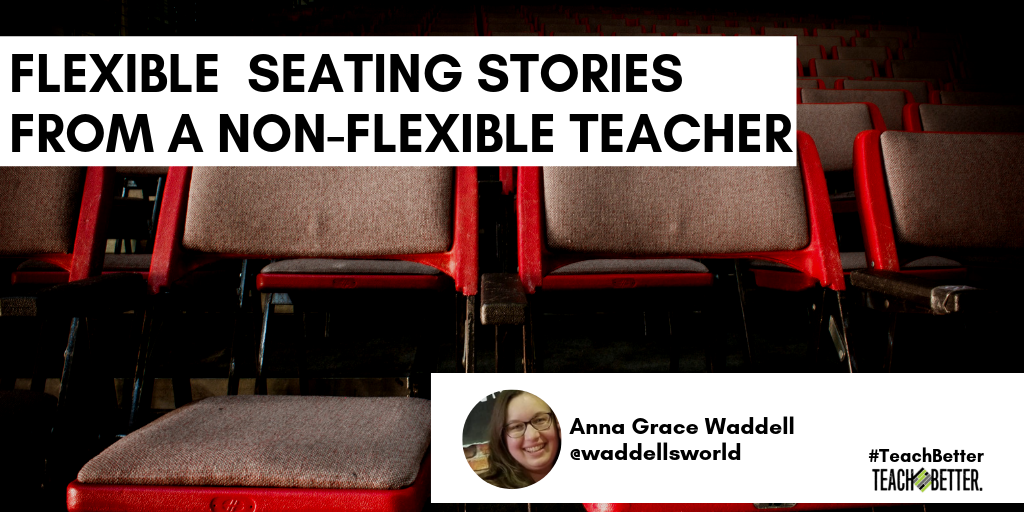In This Post:
- The flexible seating movement has been going strong for a while now.
- There is a big misconception that the optimal learning environment requires kids to sit in desks with hard chairs.
- Flexible Seating Does Not Equal No Structure
- Not all teachers are the same
- Get out of your comfort zone.
- Even if flexible seating is too much, there are things you can do.
Two years ago, the flexible seating movement really took off in education circles. Teachers started posting pictures of their classrooms filled with a hodge-podge of furniture they gathered from different sources, from second hand stores to Donors Choose projects to yard sales. I read the testimonials from teachers in a variety of grade levels write how the change in seating often precipitated a shift in teaching and student activities. The choice of seating helped increase student engagement and the non-traditional seating often encouraged teachers to think differently about their curriculum choices throughout the year. I became intrigued with this concept but had to overcome my own hang-ups about changing something that had such a large impact on my teaching.
Preparation
I did a large amount of research but also thought about how I could arrange the room to accommodate the direct instruction model. You see I deliver a large portion of content directly to students and love having lively class discussions; I didn’t want an arrangement where students had their back to me or couldn’t see the projector screen and therefore thought most of the grouping models would not be the best fit in my classroom. Instead I reflected on the stadium seating you find in many college classrooms, tiered at different levels so all students can clearly see instruction. I also went to my principal (who was very supportive!) to ask about purchasing furniture through the school. She readily agreed and I worked on developing my layout and deciphering what setup would best serve in my classroom.
Had you told me three years ago that I would have game chairs, camping chairs, and a couch in my classroom, I would have laughed. No way! Click To TweetI decided to design the room with three levels: low, medium, and high. The seating and table would need to suitable for students to work comfortable at each. Using white board tables at each level, I went about finding seating options.
Low:With two whiteboard tables built to the lowest setting, students at this level would either sit at floor level or slightly elevated. I bought four wobbly cushions and four stadium seats that students could use. I also purchased two large rugs to be centered under each table so students had a barrier between them and the bare carpet. I also arranged four game chairs that slightly reclined with large plastic clipboards for them to use to support their notebooks or chromebooks.
Medium:I centered a couch in the center of the room with two whiteboard tables on either side. Again, I had large clipboards for students to use while seated at the couch and at the tables, I had a variety of chairs to sit at both ends and two on one side so they could face the front of the room. Some were similar to those found in other classrooms but I also had a friend who worked in the maintenance department at our board of education give me chairs that had been sent by different vendors for the school district to consider purchasing. They had been sitting in storage and came in several different colors and styles. I had several wobble stools at the same height as the chairs. Lastly, I had two standing desks in the back corners of the room. While they were slightly higher than the tables, both had a computer desk chair where students seated there could adjust the height to their liking.
High:I wanted to keep the same type of table throughout so again I had two whiteboard tables for the back of the room. I simply purchased risers so they could sit elevated behind the couch. I situated the tables sharing the inner corners so it could comfortable seat two stools at both ends and four stools along the backside.
[scroll down to keep reading]Lessons Learned Along the Way:
You Do You: When I first started looking at flexible seating arrangements, I struggled to figure out how to make it worth with my teaching style. I wanted to be able to see all students and have them face the front of the room. I wanted a layout that would best fit my philosophy. Now yes, I know I was blessed with an administrator that funded my vision but I still think that had I needed to seek out an arrangement that didn’t mirror many of the photographs I saw during my research. So take some time and identify your goals and try to imagine how changing the furniture will impact your instruction.
Flu Season:Essentially all of the furniture I purchased could be disinfected, which is often the challenge during the periods of time that the whole school seems to be sick. From the tables to the chairs to even the couch, I tried to pick pieces that could be easily wiped down by either myself or a small group of students.
Wear and Tear:I don’t know about your students, but my kids aren’t exactly easy on the furniture. I had to handle this in two approaches: 1-teach and expect the students to respect the furniture and not aid in its eventual demise and 2-understand that certain pieces weren’t necessarily meant for what I had imagined for it. For instance, I chose a couch that had four small legs under the four corners. Around December, one of the back legs became a little twisted and eventually gave in on itself. I noticed this on my planning period and didn’t really have the time or materials to start drilling and supporting the internal structure. Solution? I just took off the rest of the legs and the couch sat about four inches shorter. Yes, the kids noticed and while a couple complained, I simply reminded them that they didn’t have to sit on the couch and could simply sit somewhere else. All of a sudden, it wasn’t that big of a deal. But know this going into a flex seating situation, most furniture isn’t designed for close to 100 students using it on a daily basis. If the furniture or material seems not that strong, stay away!
Creatures of Habit:I shifted away from assigned seats this year (which was a huge change for me!) and allowed the students to pick where they wanted to sit on a daily basis. My only rule: make wise decisions on whom to sit by. Sure there were times I had to move a student or two, but in general they did relatively well with having the option. Two things I noticed:
1-Kids were rarely if ever late to my class. You certainly weren’t going to get a seat on the couch or in a camping chair if you took your time in the hallway.
2-Some students wanted to sit in the exact same location everyday. For instance, my first two classes were both gifted students. My homeroom kids pretty much had settled into their preferred seats mid-fall, despite my encouragement to try new seats. My next class on the other hand, I couldn’t predict where they would end up. But either way the kids loved the flexibility of having the choice.
The Big Takeaways
- Discomfort Does Not Equal Learning: There is a big misconception that the optimal learning environment requires kids to sit in desks with hard chairs. Not true! I had kids who wanted to sit or lay on the floor during work sessions and as long as they were working, I totally let them. Quite often, students requested to come work in my room from other classes during these workdays because I allowed them the flexibility to pick the seating that was best for their learning. I even had a student return from surgery and sitting on hard surfaces was really painful those first couple days back. She asked to borrow one of my camping chairs for her other classes and was able to function just fine. While there are certainly teachers out there who find sitting at a desk to be the best place to grade papers and plan, I certainly prefer a couch to get my work done! Why don’t we give students the same choice?
- Flexible Seating Does Not Equal No Structure: I am by far one of the strictest teachers in the grade level and in my opinion, I have to be in order for this arrangement to work. I have certain hard and fast rules that make this setup successful: three people on the couch. I don’t care if there are four tiny girls who wear a size zero and are barely five feet tall; three people on the couch. Another rule: no eating in class. Our school struggles with pests of several sizes and I cannot have pieces of cereal ground into my rugs or pancake syrup caked on the white board tables. Students know the appropriate times to eat and my class isn’t one of them (and yes-that goes for me as the teacher too)!
- Not all teachers are the same: This was a lesson for both my students and my colleagues. A number of my students became frustrated that I gave them choices that they weren’t allowed to make in other classes. A number of teachers were resentful that I got new furniture. The fix? Lots of conversations! For students, it was the discussion that not all teachers expect the same thing and we, as individuals, have to meet the expectations of the authority figure. I often reference a former principal who mandated that no staff members (including the custodians) could wear tennis shoes to school. It wasn’t easy but that was the rule. For my colleagues, it was the discussion that I show a level of care in my room to the items in there. For instance, you will never see my chromebook cart not neatly arranged or colored pencils strewn across my floor. My administration knows this so when I asked for furniture, there wasn’t the worry that after one year (or even only a couple months), items would be destroyed or unusable.
- You’ve Got to Get Out of Your Comfort Zone: Had you told me three years ago that I would have game chairs, camping chairs, and a couch in my classroom, I would have laughed. No way! Kids need structure and stability! But I also pay attention to trends and data and know that the old way of doing things isn’t always what’s best for kids. Every year in our teacher evaluation system, we are asked to identify personal goals and I take that challenge seriously. I try to implement one thing each year that pushes me professionally and not only are the kids better for your efforts, but you will grow tremendously as an educator.
If flexible seating seems like too big of a jump, try something you feel is more reasonable but still a challenge. The year before I implemented a complete change in furniture, I went from desks to tables and chairs. Some may think that is a minor change, but for those of use who have done it, it is a big shift in how you view your room. You also have to know where you are professionally. In no way would I suggest this model for a teacher in the first couple years in the profession. I knew my pedagogy and classroom management were developed enough for me to add in a challenge in a different area. Lastly, do the research. Have it handy when you talk to your administration and colleagues. Don’t go from yard sale to second hand stores without a clear vision of what will work best in your classroom.
About Anna Grace Waddell
Anna Grace Waddell is a 7th grade social studies teacher in Coastal Georgia. She has served as a public school teacher and also worked at a psychiatric residential facility as both a teacher and administrator. Currently serving as grade chair at a middle school, she has found her happy place that allows for some leadership responsibilities but mostly centers on building relationships with some awesome kids and delivering content that is challenging and engaging. Mrs. Waddell is hoping to add the title of Doctor quite soon as she is in the last stages of finishing a doctorate in education at Georgia Southern University and will achieve triple eagle status! #GoEagles




